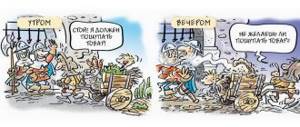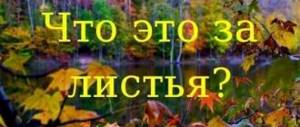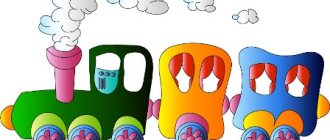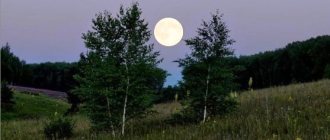Children about trees, or what are the benefits of the forest
It is impossible not to admire nature and what it creates. Just look at the stately green giants spreading their branches! Their lush green color provides a rest for the eyes in the summer, in the fall we marvel and enjoy the sudden changes in leaf color, in the winter we look at the intricate white caps, and in the spring we watch as the trees magically come to life again after a long winter hibernation.
But we not only admire their beauty, but also accept what they give us. Firstly, and most importantly, tree leaves produce the oxygen that we breathe.
Secondly, they help clean the air from harmful substances, especially in the city, where life is literally in full swing.
Thirdly, some trees bear fruit, delicious fruits grow on them, which we all love very much, that is, trees help us feed ourselves.
Fourthly, a lot of things vital for people are made from wood: paper, carved furniture, entire houses, musical instruments. Therefore, it is very important not to forget about the benefits of trees, carefully preserve the forest and live in harmony with nature.
Tree classification
Let's take a walk in a park or forest and take a closer look at different trees. How are they different from each other? How can they be separated? What types of trees are there and what types of trees are there?
Trees are divided into two large groups: coniferous and deciduous.
Coniferous trees, or evergreens, are distinguished by the fact that instead of leaves they have peculiar needles. There are dwarf conifers and giants. The class of coniferous trees includes: pine, spruce, fir, cedar, cypress.
The second group is deciduous. They are distinguished by the shape of the crown, the color of the foliage and the ability to bear fruit. It is deciduous trees that have the property of changing the color of the leaves, then the leaves fall, the tree overwinters and in the spring green foliage is born again from the buds. Deciduous trees usually include birch, linden, maple, oak, chestnut, ash, aspen and others.
A separate subgroup is fruit trees. That is, those that can bear fruit. These include, for example, apple, pear, plum, cherry, apricot. Deciduous trees are also divided into evergreen and deciduous. Deciduous plants shed their foliage in late autumn, while evergreens change their foliage gradually at any time.
The video below gives a detailed description of some trees and their beneficial properties:
The tree itself consists of:
- root The root performs the main function - it nourishes the tree with the necessary substances and water.
- trunk The trunk serves as a support for the crown. Its amazing feature is the rings when cut: their number indicates the age of the tree. And trees can live for several centuries)))
- crowns with branches and leaves. The crown combines spreading branches, flowers, fruits and seeds. The crown can have different shapes: oval, round, spreading, weeping, etc.
How do trees reproduce?
Trees can reproduce in three different ways.
- Method 1. Every tree has fruits that contain seeds. The time comes, the seeds ripen and spread across the earth with the wind. Once they are in a favorable environment, they begin to grow. At first these are small sprouts, and then whole trees.
- Method 2. A tree can be grown from a cutting or from the buds of a cutting. The twig is also planted in a suitable environment and wait until it produces a root. Gradually the tree will begin to grow and develop.
- Method 3. You can grow a tree from the roots of the parent tree. From the root grows a sprout, and then a tree. Cherry, sea buckthorn, willow and many others reproduce from the roots.
Interesting facts about trees
- Now trees occupy about 40 million hectares of land, but, alas, this figure is becoming smaller. And this is about 60 times more than there are people in the whole world.
- The most trees are in Finland and Montenegro. They occupy about 70% of the entire territory. But the least number of forests is in Great Britain.
- The most common tree on the planet is birch.
- The tallest tree in the world is the sequoia, which grows in America; its height is as much as 112 meters.
- Sequoia is the most ancient tree.
- The most expensive wood is mahogany mahogany.
- Half of all coniferous trees grow in our country.
- Trees grow throughout their lives.
- Trees have incredible power. Even a small sprout can break through the asphalt on its way.
- To make one sheet of paper, 15-20 grams of wood are required.
What should children read and watch about trees?
When studying the topic of trees and plants, use any available means: free coloring books for children, books, films, cartoons. When telling children about trees and amazing seasonal metamorphoses, I confidently recommend my favorite fairy tale, “The Adventures of an Oak Leaf.” What else can you read about trees? We recommend that you familiarize yourself with the following works:
- Fairy tale "Dispute of trees".
- Dmitry Chekhov "The Tale of the Old Oak".
- Mikhail Prishvin “The aspen trees are cold.”
- Meller Anne "By land and air: how plants travel."
- Mikhail Prishvin "Squirrel Memory".
- Burmistrova Larisa “Tell the children about trees.”
What is the best thing to watch about trees with children?
In the playlist below we have collected the most interesting cartoons and films about trees. Watch them with your children and reinforce their knowledge:
So we learned about what trees are, what they are like, how they reproduce, why they are so important for humans and we have become one step closer to living nature!
Text of the book “Tell Children About Trees”
Larisa Burmistrova, Victor Moroz Tell children about trees
BIRCH
In a white sundress, with handkerchiefs in pockets, with beautiful clasps, with green earrings. (A. Prokofiev)
The birch tree is considered the symbol of our country. Since ancient times, songs and poems have been written about this tree:
There was a birch tree in the field, and
a curly birch tree standing in the field.
* * *
The white birch tree under my window
was covered with snow, like silver, on the fluffy branches with a snowy border, the brushes blossomed with a white fringe. (S. Yesenin)
Birch is unpretentious and grows on dry sands and marshy soils. It can be found in the forest, in the field, and in parks.
In early spring, when the buds swell on the trees, flowers appear on the birch - inconspicuous earrings. In summer they noticeably increase in size and turn brown. Each ripe earring contains several hundred small seeds. And on a whole adult tree, in fruitful years, up to several million of them can ripen. The smallest fruits, similar to a very small butterfly with open wings, are carried by the wind over long distances and germinate in suitable soils the following spring. That is why birch is one of the first to occupy vacant plots of land.
The white bark of birch - birch bark - reflects the sun's rays and protects the tree from overheating.
Since ancient times, birch bark has been used to make household products. Raw materials were harvested in the spring. At this time, the birch bark sheds, that is, it freely separates from the wood. The raw materials were dried in the shade and smoothed under a press. Tueskas, mugs, bread bins, boxes and other household items were made from birch bark. Bast shoes, baskets, trunks were woven from the inner part of birch bark - bast.
When people did not yet know how to make paper, they wrote on birch bark. Birch bark letters, which are 700–800 years old, have survived to this day.
Birch is still beneficial today. Furniture is made from its wood. Birch buds have healing properties and are used to prepare medicines.
MYSTERY
Sticky buds,
Green leaves, With white bark, Stands above the mountain. (Birch)
OAK
The oak tree is not afraid of rain and wind
at all. Who said that oak is afraid of catching a cold? After all, until late autumn I remain green. This means I am hardy, this means I am hardened.
Oak is a powerful, majestic tree. The trunk is thick, covered with brown-gray bark with sinuous cracks. The older the tree, the deeper the cracks. The oak is considered the personification of heroic strength. In Greece, an oak branch was a symbol of strength, power and nobility. The oak was dedicated to the patron of the arts - the god Apollo. In ancient Rome, acorns were considered divine fruits. The ancient Roman scientist Pliny the Elder wrote about oak trees: “Untouched by centuries, of the same age as the universe, they amaze with their immortal destiny, as the greatest miracle of the world.”
The oak was also considered a sacred tree by the Slavs; it was dedicated to the god of lightning and thunder - Perun.
Oak is the king of all trees.
It has a big role. (I. Goryunova)
In the middle zone there are no trees that are larger than oaks. Oak trees live 400–500 years. Single specimens reach an age of about one and a half thousand years. The oldest oak grows in Germany. Its age is about 1400 years.
Oak is a light-loving tree. Have you noticed the oak branches? They are repeatedly curved, as if twisted; in old oaks they have bizarre bends. The fact is that the branches are constantly reaching towards the sun, towards the light. So they change the direction of growth depending on the lighting.
Oak trees bloom in May. The fruits - acorns - ripen in the fall. Many forest dwellers like to eat acorns: wild boars, deer, field mice, jays.
Oak has valuable wood: dense, hard, durable with a beautiful texture. It is used in shipbuilding, furniture, and carpentry.
PUZZLES
I crawled out of the little barrel,
put down roots and grew up, I became tall and powerful, I am not afraid of thunderstorms or clouds. I feed pigs and squirrels - It’s okay that my fruit is small. (Oak)
* * *
Hidden in this smooth
Bronze-colored of Future Summer. (Acorn)
CHESTNUT
The sun rose early and
looked into the house. The chestnut trees are blooming outside my window. A bird sings Close, close somewhere, So the Golden Summer is coming. (G. Boyko)
Horse chestnut is a majestic tree with a spreading, dense, uniform, highly vaulted crown. The trunk of mature trees is very powerful, usually straight. This tree reaches a height of 25–30 meters.
Horse chestnut deservedly enjoys the reputation of one of the most beautiful park trees. It is often planted in parks and gardens, near houses and cottages. In early spring, large sticky greenish-pink buds appear on the chestnut tree. After a few days, original large leaves appear, divided into 5–7 leaflets.
In early May, the chestnut tree blooms. Its flowers are very beautiful - pyramidal panicles up to 30 centimeters high, consisting of large white flowers with yellowish or reddish droplets of juice. Flowers that resemble candles on a Christmas tree give the tree a unique look. Chestnut fruits also look attractive: green, spherical capsules with numerous thorns, each containing 1–3 shiny, dark brown seeds.
Noble chestnut grows in the southern regions. It is so different from horse chestnut that scientists place them in different families. They are similar only in appearance, in both species they are shiny, brown, like polished nuts, enclosed in almost identical shells, only in the edible one it is brown with spikes, and in the horse chestnut it is bright green with tubercles. It is difficult to say exactly why the chestnut began to be called horse chestnut. There are two versions. According to one of them, after the leaf falls, a scar resembling the mark of a horse’s shoe remains at the place where the petiole is attached to the branch. According to the second, there is a gray spot on the dark brown surface of the fruit, similar to the imprint of a horse's hoof.
Horse chestnut wood is used in furniture production to make high-quality barrels. An extract prepared from the bark is used to tan leather and dye cotton, wool and silk fabrics dark brown and olive green. Baskets are woven from young branches.
MAPLE
In the thick blue,
an orange-red, maple leaf flew above me. I run after him: He, as if teasingly, beckoned me somewhere with him. The leaf, Tired of circling in the heights, trustingly sat on my palm. (G. Osinova)
Maple trees are easily distinguished from other trees by their large, patterned leaves with five sharp points. Maple is especially beautiful in autumn. The leaves on the maple are painted in different colors: yellow, red, orange, crimson, golden. The tree transforms, becomes so elegant that you can’t take your eyes off it. It's hard to resist collecting a bouquet of leaves.
Maple greets the very first
arrival of Autumn. cheerful round dance of Leaves circles in the air , quickly covering the Earth with a Golden carpet - Let the dear one fall asleep in a long winter sleep.
In spring, the maple is one of the first to awaken. As soon as the snow begins to melt, the roots of the maple absorb moisture from the ground and drive it along the trunk to the branches. If you make a cut on the tree at this time, sap will flow out of it. Maple sap is sweet and contains 2–3 percent sugar.
At the end of April, the maple begins to bloom. Its flowers are inconspicuous: small, yellowish-green, but they have a strong attractive scent. In addition, there are not many flowering plants at this time, so bees and other insects flock to the maple tree, collect sweet nectar and pollinate the plant.
Maple fruits look like small propellers. In autumn, they break away from the branches, and the wind carries them around the surrounding area.
Maple is a fast-growing tree. Young shoots that receive enough moisture, heat and light grow by about a meter per year.
Maple wood is white, with a red-brown or yellowish tint. It planes perfectly and retains its shape. Maple wood can be easily bent, which is why it has been used for making musical instruments since ancient times. Back in the 9th century, the Slavs made harps from maple. In the Middle Ages, maple became widely used in the manufacture of strings, bows and other musical instruments. Nowadays, sonorous violins and guitars are made from maple. They also make skis from maple, which are fast and light.
LINDEN
I grew up, sticky,
thin and flexible - Don’t break me! as a honey-bearing flower in the summer - Take care of me. At noon, under me You will hide from the heat - Grow me. I will cover you from the rain with leaves - Water me. Together, my dear friend, Let's gain strength - You love me. And if you wait until the deadline, you will go out into the wide world - Don’t forget me! (P. Voronko)
Linden is a slender tree with a dense crown. On a hot summer day it is always cool in its shade, so linden was planted in the parks of ancient noble estates.
Unlike many trees, linden blooms quite late - in late June - early July. Its flowers are yellowish-white, collected in small clusters. They look unattractive, but they produce a large amount of nectar. Linden is the best honey plant. Bees fly around it all day long, collecting sweet nectar.
A linden flower produces 2–3 milligrams of nectar per day. Linden honey contains many useful substances. Linden flowers also have healing properties. Linden tea is drunk for colds.
In winter, linden attracts jays, woodpeckers, and squirrels - the linden fruits remain overwintering on the tree. So the forest inhabitants rush to feast on them.
Linden is a good neighbor for other trees. There are never any old fallen leaves under the linden tree; they quickly rot and return nutrients to the soil, including the calcium needed by plants.
Linden wood is plain white, without shades, and soft. Since ancient times, it has been used to cut window frames, make carved kitchen utensils, toys, and musical instruments.
The bark of young linden trees used to be stripped of bast, from which bast shoes were woven.
MYSTERY
takes the most delicious honey from my flower
. And everyone offends me: They take off the thin skin. (Linden)
PROVERBS AND SAYINGS
The pine tree feeds, the linden tree clothes.
ALDER
The alder little by little learned
to put an earring behind an earring, and when she was quite grown up, she brought you two earrings. And she’s not a fashionista at all, but that’s how it is in the world: Everyone wants to grow up, Everyone wants to blossom. (E. Serova)
Alder is a short tree with a thin, often crooked trunk. Its bark is gray-greenish, always smooth, even on old trees.
Alder blooms in early spring, and long catkins bloom on the branches even before the leaves appear. According to a long-standing custom, girls came out to watch the alder blossom. The beauty of a girl was compared to the beauty of an alder tree. She blooms in magnificent colors, like a beautiful girl. Bees flock to the blooming alder trees, boys stare at the beautiful girls. Beekeepers tried to release the bees from the hives at the time of alder flowering so that they could collect food from the sticky leaves.
The leaves of alder are matte green above and gray-green below. Even in autumn they do not change color and fall to the ground green. Fallen alder leaves are rich in nitrogen. This element is necessary for the normal development of plants. Alder leaves rot quickly enough and enrich the soil with nitrogen.
Alder roots live in close symbiosis with certain soil bacteria. To do this, they form special nodules, like legumes. But unlike legumes, they are inhabited not by bacteria, but by so-called radiant fungi. They absorb nitrogen from the air and return it to the soil. Where alder grows, the soil improves significantly. This tree is very useful for the forest.
Alder roots are located at a shallow depth, and the main shoots often grow on them. Alder grows very quickly and therefore is the first to colonize cleared areas and abandoned arable land. Alder is often planted to strengthen the soil on dumps or freshly filled soils.
Alder wood has an orange tint. A fresh alder stump is bright orange, almost orange in color.
Alder wood, soaked in water, is durable and does not rot. For a long time in Rus', well log houses were made from it. And now it is used for the construction of underwater structures.
FOLK SIGNS
The alder blossomed - this buckwheat.
The gray alder began to dust, the golden-green wings of the willow blossomed, the lark began to sing - it was time to go out into the arable land.
If Indian summer is stormy, autumn is dry, dry as black alder.
ASPEN
The aspen tree
is colored by autumn. I like Aspen very much. It shines with gold, There is only one pity - It flies around. (V. Lunin)
Even in calm weather, in an aspen forest you can hear the faint noise of rustling leaves, as if they were constantly whispering about something. If a breeze blows, the aspen leaves begin to sway and rustle.
You've probably heard the expression: “trembles like a leaf.” This is what they say about a person who is cowardly or overcome by fear. This expression did not arise by chance. For a long time, people have noticed that at the slightest breath of wind, aspen leaves begin to rustle - “tremble.” Why is this happening? Aspen leaves are round in shape and sit on a long petiole. When air moves, they begin to sway, hit each other and make noise. It is interesting that the leaves of young shoots are completely different from the leaves of an adult tree. They are larger, softer, slightly pubescent, with a pointed tip. The petioles of young leaves are short and round in cross-section, and they cannot “tremble”.
Aspen blooms in early spring. The leaves have not yet bloomed, and the aspen is covered with long, shaggy catkins. In autumn, aspen leaves are among the first to acquire elegant colors in different shades: from soft yellow to bright crimson.
Aspen fruits ripen in autumn. Its seeds are light and small. Thanks to their fluffy crest, they fly over long distances. Young aspen trees are characterized by rapid growth. Young trees (up to 30 years old) grow 1.5–2 meters annually. The life expectancy of aspen is 60–80 years.
Since ancient times, aspen wood has been used as a finishing material in the construction of wooden churches. From it they cut a ploughshare - a patterned shingle that covered the domes. Properly dried wood is second only to oak and pine in strength, so it is suitable for making boats and skis.
MYSTERY
What kind of tree is there -
There is no wind, but the leaf is trembling? (Aspen)
FOLK SIGNS
Aspen in catkins - harvest for oats.
Just as the aspen trembles, so the cattle in the field are well fed.
In autumn, one berry is a bitter rowan, one tree is a bitter aspen.
PINE
The pines want to grow to the sky,
They want to sweep the sky with their branches, So that the weather will be clear throughout the year .
Pines are slender, tall trees, with beautiful golden trunks. The lower branches of pine trees die quickly because nutrients in the lower parts of the trees are consumed faster than they are accumulated during photosynthesis. Therefore, the pine forest resembles a bright temple with majestic columns. Northern Europeans created many tales about this tree. In the East, they believe that pine trees ward off misfortune and bring happiness. Being in a pine forest is not only pleasant, but also useful. The air there is always clean. Pine trees produce essential oils that kill germs.
All year round: pine remains green both in winter and summer. The needles on it are not replaced all at once, but gradually: some needles fall off, and new ones grow in their place. Pine needles are longer than spruce needles and are attached to the branch two needles at a time.
Pines are photophilous plants that love space and sun. You look at the pine forest and it seems that the pines are stretching upward, closer to the sun.
Pines can be found on sandy soils, in swamps, on rocks, among crevices. They are not capricious and can adapt to different conditions. The roots of the pine tree are powerful and large. On sandy soils, the roots rush down, extracting life-giving moisture. On swampy soils they tuck in to escape excess moisture.
Pines are the most ancient trees on our planet. Scots pine, common in the middle zone, grows for 300–500 years. Long-living pines are found in North America. Bristlecone pine grows in the highlands of California. In 1955, one of these pines was cut down. It turned out that her age is 4900 years. It is older than the Egyptian pyramid of Cheops. Now all long-lived pines are taken under state protection. Among them there are many trees older than 4000 years.
MYSTERY
I have longer needles
than the Christmas tree. I'm growing very straight in height. If I'm not at the edge, the branches are only at the top. (Pine)
FOLK SIGNS
A lot of cones on pine and spruce trees - for a good year: both rye and wheat - everything will come.
In a storm, if you listen carefully, the pine tree rings, and the oak tree groans.
WILLOW
Let's sit here by this willow tree.
What wonderful twists on the bark around the hollow! And under the willow, how beautiful are the golden tints of streams of trembling glass. (A. Fet)
Different types of willow have received their own memorable names among the people: willow, broom, willow, black-talk, white-willow.
Willow is found everywhere: from the desert polar tundra to the steppe Central Asia. In the north it reaches only a few centimeters, and in the south there are huge 30-meter trees.
Near the river near the cliff,
the willow is crying, the willow is crying. Maybe she feels sorry for someone? Maybe she's hot in the sun? Maybe a playful wind pulled the willow by its pigtail? Maybe the willow is thirsty? Maybe we should go ask? (I. Tokmakova)
Willow has long roots, so it is planted to consolidate loose sand, strengthen the banks of canals, slopes, dams, and to create forest belts. Weeping willows, which are planted in parks and along the banks of reservoirs, look very beautiful.
If you see a willow tree, then you know that somewhere very close there is water - a pond or river. In the old days, people looked for water using a willow twig. Where the twig trembles and bends down means that there is an aquifer deep in the ground, and this is where you need to dig a well. People who searched for water with a willow twig were called dowsers.
In spring, the willow blooms and its branches are covered with catkins. Ripe fruits open, releasing light, feather-like seeds. The wind carries them far from the parent tree.
Willow seeds have an amazing ability. Having fallen to the ground, they begin to germinate within an hour! After a day, the seed acquires a tail—a root—and a stem rises up.
Many animals feed on young shoots of willow. In the tundra, deer feed in thickets of willow trees, and elk feed in the forest zone. Willow twigs are used to weave baskets and make wicker furniture. Various crafts are made from white willow wood.
MYSTERY
The buds are silver,
the flowers are gilded, and the skin on the branch is red. (Willow)
POPLAR
Poplar - everyone knows it -
a champion in growth. And it’s not at all easy for you to get the top of my head, Because I grow two meters over the summer.
Poplar is indeed one of the fastest growing trees in the middle zone. It reaches impressive sizes in a short time. Over the course of a year, poplar grows 1.5–2 meters. This tree is unpretentious and does not require special care.
Poplar is used more often than other trees for street landscaping. Besides fast growth, it has other advantages. This majestic slender tree with a greenish-gray smooth trunk and dense crown fits perfectly into landscape design and decorates city parks, squares, and streets. In the city, poplar plays the role of a nurse. It cleans the air of dust and soot and releases a large amount of oxygen into the atmosphere.
Let's take a closer look at the poplar leaves. They are shiny dark green above and light with white pubescence below. Such pubescent leaves are capable of capturing significant amounts of dust from the air. It settles in the hairs, and during heavy rainfall it is washed off and carried away by the flowing water. If there is too much dust and soot and the air is very polluted, poplar leaves give a distress signal - they become small, covered with spots, and thin out. It is necessary to take measures, because it is impossible not only for poplars, but also for humans, to live in such conditions.
Poplar blooms in early spring, even before the first leaves bloom on it. Already at the end of May, fruits ripen on the poplars - capsules with a large number of small seeds. These seeds are covered with long silky hairs - popularly called poplar fluff. The boxes burst and a “white blizzard” hits the city. Poplar fluff, like snow, covers the ground and trees.
- Confess to us, rooster,
Why is there fluff everywhere? You are a notorious bully! There must have been a fight here? - I haven’t fought for eight days! The fluff flies from the poplars! (M. Druzhinina)
Poplar fluff quickly absorbs moisture, thereby creating good conditions for seed germination. A poplar seed swells in 4 hours, and after 8-10 hours a root appears.
Poplar wood is soft and light. They make plywood and paper from it. Poplar buds are used in cosmetology.
SPRUCE
What kind of girl is this:
Not a seamstress, not a craftswoman, She doesn’t sew anything herself, But she wears needles all year round. (A. Rozhdestvenskaya)
Which tree do we always decorate with toys for the New Year? That's right, a Christmas tree. The spruce, or scientifically spruce, is a relative of other coniferous trees such as pine or cedar.
Spruce has a denser crown than pine. It tolerates a lack of light well and does not die, but simply stops growing. Spruce requires moist, nutritious soil to grow well. Spruce trees are slender trees with fluffy branches covered with pine needles. Norway spruce is the tallest tree in Europe, reaching a height of 70 meters.
They ate at the edge of the forest - the tops of their heads reach to the sky -
They listen, remain silent, and look at their grandchildren. And the grandchildren, the Christmas trees, thin needles, dance in circles at the forest gates.
If the leaves of deciduous trees turn yellow and fall off in the fall, then the leaves of coniferous trees remain green in the winter. The only coniferous tree that sheds its needles every year is larch.
In our country, common spruce grows in the European part, Siberian spruce grows in the Urals and Siberia, Korean spruce in the Far East, oriental spruce in the Caucasus, and Finnish spruce in Karelia. That's how many types!
The central squares of Russian cities are decorated with blue spruce trees. Their homeland is North America. The unusual blue color of the needles is given by a waxy coating. Wood coated with natural wax can easily survive both harsh winters and dry summers.
You will always find her in the forest -
Let's go for a walk and meet her: Standing prickly like a hedgehog, In winter in a summer dress.
Spruce lives for several hundred years; the oldest spruce trees in our country were found in the Kostroma region. They are more than 500 years old.
Spruce wood is soft, pleasant white or yellowish in color. It makes beautiful furniture. Paper and musical instruments are also made from spruce wood.
PUZZLES
Winter and summer in the same color.
(Spruce)
* * *
Her clothes are pins and needles -
all needles and needles. The animals joke: “Uncle Hedgehog looks a little like her!” (Christmas tree)







